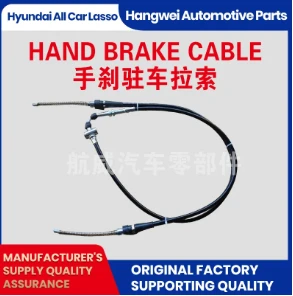clutch line to slave cylinder
Understanding the Clutch Line to Slave Cylinder Connection in Vehicles
The clutch system of a vehicle is a crucial component that links the engine to the transmission, enabling smooth gear shifts and vehicle control. A key part of this system is the connection between the clutch line and the slave cylinder, which plays a vital role in engaging and disengaging the clutch. Understanding this connection is essential for any vehicle owner or mechanic, as it impacts the overall performance and reliability of the vehicle.
The Role of the Clutch Line
The clutch line, often made of durable rubber or metal tubing, serves as a conduit for hydraulic fluid. When the driver presses the clutch pedal, this action generates pressure in the hydraulic system. The fluid travels through the clutch line to the slave cylinder, which then pushes against the release bearing, disengaging the clutch. This process allows the driver to change gears smoothly, transitioning power from the engine to the wheels.
The Slave Cylinder Explained
The slave cylinder is a hydraulic actuator that functions under pressure. It consists of a piston within a cylindrical housing. When the hydraulic fluid from the clutch line enters the slave cylinder, it pushes the piston forward, thereby disengaging the clutch. This engagement allows for changes in gear ratios without grinding the gears, ensuring efficient power management and enhancing driving comfort.
Common Issues with Clutch Line and Slave Cylinder
Over time, various issues can arise with the clutch line and slave cylinder connection, affecting vehicle performance. One of the most common problems is fluid leaks. A compromised clutch line or defective slave cylinder can lead to a loss of hydraulic fluid, making it difficult or impossible to disengage the clutch. Symptoms of such issues often include a spongy or unresponsive clutch pedal and difficulty shifting gears.
Additionally, the slave cylinder can suffer from wear and tear, especially in older vehicles. The internal seals might degrade, leading to fluid leaks and reduced effectiveness of the clutch operation. Regular inspection and maintenance of the clutch system, including the line and cylinder, can help prevent these issues from becoming severe.
clutch line to slave cylinder

Maintenance Tips
To ensure the clutch line and slave cylinder function properly, regular maintenance is vital
. Here are some essential tips1. Regular Inspections Periodically check the entire clutch system for signs of wear or fluid leaks. This includes examining the clutch line for any visible damage and the condition of the slave cylinder.
2. Fluid Level Checks Keep an eye on the hydraulic fluid levels in the reservoir. A decrease in fluid can indicate a leak in the system.
3. Replacement of Worn Components If the clutch line shows signs of deterioration, or if the slave cylinder is leaking, it’s important to replace these components promptly to maintain clutch performance.
4. Professional Servicing Consider having a qualified mechanic perform a thorough inspection and service of your clutch system, especially during routine vehicle maintenance.
Conclusion
The connection between the clutch line and the slave cylinder is critical for the proper functioning of a vehicle's clutch system. Understanding its role and recognizing potential issues can lead to better maintenance practices and improved vehicle performance. By staying proactive and ensuring that these components are in good condition, drivers can enjoy smooth gear transitions and a more reliable driving experience.
-
Upgrade Your Control with Premium Throttle CablesNewsAug.08,2025
-
Stay in Control with Premium Hand Brake CablesNewsAug.08,2025
-
Experience Unmatched Performance with Our Clutch HosesNewsAug.08,2025
-
Ensure Safety and Reliability with Premium Handbrake CablesNewsAug.08,2025
-
Enhance Your Vehicle with High-Performance Clutch LinesNewsAug.08,2025
-
Elevate Your Ride with Premium Gear CablesNewsAug.08,2025
